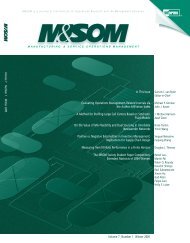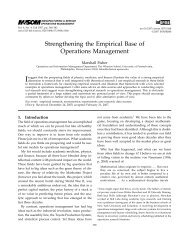Store Manager Incentive Design and Retail Performance: An ...
Store Manager Incentive Design and Retail Performance: An ...
Store Manager Incentive Design and Retail Performance: An ...
You also want an ePaper? Increase the reach of your titles
YUMPU automatically turns print PDFs into web optimized ePapers that Google loves.
DeHoratius <strong>and</strong> Raman: <strong>Store</strong> <strong>Manager</strong> <strong>Incentive</strong> <strong>Design</strong> <strong>and</strong> <strong>Retail</strong> <strong>Performance</strong><br />
Manufacturing & Service Operations Management 9(4), pp. 518–534, © 2007 INFORMS 531<br />
of the store manager to impact sales <strong>and</strong> shrinkage<br />
<strong>and</strong> the relative importance of each measure to firm<br />
profitability.<br />
Moreover, Tweeter has successfully achieved similar<br />
results at other retailers acquired since BMS. Once<br />
again, incentives played a key role in changing behavior<br />
<strong>and</strong> performance at these newly acquired retailers.<br />
Forexample, at anotherchain acquired by Tweeter,<br />
salespeople had been rewarded based on sales revenue<br />
rather than on gross margin or store-operating<br />
profit. Not surprisingly, high-price items (e.g., largescreen<br />
TVs) that often had low gross margins received<br />
more attention <strong>and</strong> accounted for a relatively large<br />
portion of this chain’s sales. <strong>Manager</strong>s even allowed<br />
salespeople to negotiate price on such items in order<br />
to achieve store sales goals. By changing the incentives<br />
at these stores to emphasize operating profit,<br />
Tweeterwas able to change the sales mix at these<br />
stores considerably. High gross margin items such as<br />
receivers <strong>and</strong> amplifiers increased from 27% to more<br />
than 30% of the overall business. Despite the fact that<br />
comp store sales decreased following the acquisition,<br />
this focus on profitable sales ensured that the contribution<br />
that each store made to the retailer’s profit<br />
increased. We have anecdotal evidence that retailers<br />
in othersegments face similarchallenges in designing<br />
incentives forstore managers. At one Texas-based<br />
convenience store chain, store managers were paid<br />
according to seniority rather than according to the<br />
performance of their stores. Recently, the incentives<br />
were changed so store managers received a percentage<br />
of store profit. In doing so, the chain found that<br />
not only were expenses controlled more effectively,<br />
but that sales also increased substantially.<br />
<strong>Retail</strong>ers often seem to forget that they are dealing<br />
with multitasking agents in theirstores. Consequently,<br />
when faced with a situation where they<br />
want to affect one performance measure, retailers may<br />
change the incentives associated with that measure<br />
alone. They often fail to note that changing the incentives<br />
associated with one performance measure without<br />
regard to others might substantially hurt other<br />
performance measures. Two examples serve to illustrate<br />
this notion. In spite of the dramatic performance<br />
achieved afterthe acquisition of BMS, some Tweeter<br />
managers were uncomfortable with the higher levels<br />
of store shrinkage, <strong>and</strong> hence advocated a return to<br />
tighter control. Some of them even advocated reverting<br />
to the BMS incentive system, where store managers<br />
were penalized severely for every dollar of<br />
shrinkage. The plan to revert to the old incentive system<br />
was scuttled by othermanagers who pointed<br />
out that such punitive measures would divert attention<br />
from generating sales. To support their position,<br />
these managers were able to point to historical data<br />
as to how the stores had performed under the old<br />
incentive plan compared to their current performance.<br />
Emphasizing the multitasking nature of retailing is<br />
key because rewarding store managers for their performance<br />
on one measure has implications for their<br />
performance on others.<br />
A second example can be drawn from Gamma (see<br />
DeHoratius <strong>and</strong> Raman 2006), a large public retailer<br />
with annual sales of roughly 10 billion dollars, <strong>and</strong><br />
its concern over the accuracy of its inventory records.<br />
Afterphysical audits revealed that the company’s<br />
inventory records were often inaccurate (i.e., the company<br />
had substantially more or less inventory in its<br />
stores than indicated by the inventory computer systems),<br />
some Gamma managers suggested tying the<br />
bonus of store managers <strong>and</strong> salespeople to the accuracy<br />
of the physical audits. Although this bonus system<br />
might have reduced the discrepancy between the<br />
inventory records <strong>and</strong> the actual inventory held in<br />
the store, company managers did not consider the<br />
adverse effect that such a system might have on<br />
sales by diverting the attention of store-level employees<br />
away from key sales-generating activities. When<br />
we pointed out this trade-off, managers at Gamma<br />
quickly renounced their proposed incentive change.<br />
Additional analysis would be needed to determine<br />
whether the value of greater inventory record accuracy<br />
would offset the profit lost from foregone sales.<br />
Ouranalysis shows the importance of both using<br />
performance-based incentives <strong>and</strong> appropriately balancing<br />
the rewards for retail store managers. <strong>Retail</strong>ers<br />
must be cognizant of the way in which firm performance<br />
depends on the behaviorof store employees,<br />
<strong>and</strong> they must be sure to induce behaviors that contribute<br />
to firm profit. Doing so requires that retailers<br />
underst<strong>and</strong> how the reward for one activity impacts<br />
not only the effort allocated to that activity, but each<br />
of the otheractivities forwhich the individual is<br />
accountable.




